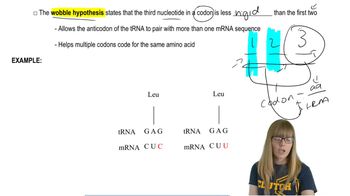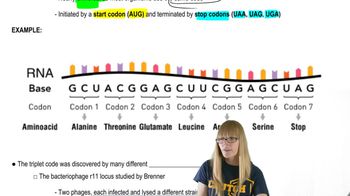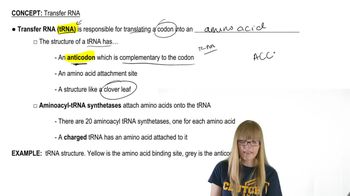Table of contents
- 1. Introduction to Genetics51m
- 2. Mendel's Laws of Inheritance3h 37m
- 3. Extensions to Mendelian Inheritance2h 41m
- 4. Genetic Mapping and Linkage2h 28m
- 5. Genetics of Bacteria and Viruses1h 21m
- 6. Chromosomal Variation1h 48m
- 7. DNA and Chromosome Structure56m
- 8. DNA Replication1h 10m
- 9. Mitosis and Meiosis1h 34m
- 10. Transcription1h 0m
- 11. Translation58m
- 12. Gene Regulation in Prokaryotes1h 19m
- 13. Gene Regulation in Eukaryotes44m
- 14. Genetic Control of Development44m
- 15. Genomes and Genomics1h 50m
- 16. Transposable Elements47m
- 17. Mutation, Repair, and Recombination1h 6m
- 18. Molecular Genetic Tools19m
- 19. Cancer Genetics29m
- 20. Quantitative Genetics1h 26m
- 21. Population Genetics50m
- 22. Evolutionary Genetics29m
11. Translation
Transfer RNA
Problem 4
Textbook Question
Francis Crick proposed the 'adaptor hypothesis' for the function of tRNA. Why did he choose that description?
 Verified step by step guidance
Verified step by step guidance1
Understand the context: Francis Crick was trying to explain how the genetic code in DNA is translated into proteins, which are made up of amino acids.
Recognize the problem: DNA is composed of nucleotides, while proteins are composed of amino acids. There needs to be a mechanism to translate the nucleotide sequence into an amino acid sequence.
Identify the role of tRNA: Crick proposed that there must be an 'adaptor' molecule that can read the nucleotide sequence and bring the correct amino acid to the growing protein chain.
Explain the 'adaptor' concept: tRNA acts as this adaptor by having an anticodon region that pairs with the mRNA codon and an attached specific amino acid that corresponds to that codon.
Conclude why 'adaptor' is fitting: The term 'adaptor' is used because tRNA adapts the language of nucleic acids to the language of proteins, facilitating the translation process.
Recommended similar problem, with video answer:
 Verified Solution
Verified SolutionThis video solution was recommended by our tutors as helpful for the problem above
Video duration:
1mPlay a video:
Was this helpful?
Key Concepts
Here are the essential concepts you must grasp in order to answer the question correctly.
Adaptor Hypothesis
The adaptor hypothesis, proposed by Francis Crick, suggests that transfer RNA (tRNA) serves as a molecular adaptor that translates the genetic code from nucleic acids to proteins. It posits that tRNA molecules bind to specific amino acids and recognize corresponding codons on messenger RNA (mRNA), facilitating the assembly of amino acids into polypeptide chains during protein synthesis.
Recommended video:
Guided course

Translation:Wobble Hypothesis
tRNA Structure and Function
tRNA is a small RNA molecule that plays a crucial role in translating the genetic information encoded in mRNA into proteins. Each tRNA has a specific anticodon that pairs with a complementary codon on the mRNA strand, ensuring the correct amino acid is added to the growing polypeptide chain. The structure of tRNA, which includes a cloverleaf shape, is essential for its function in protein synthesis.
Recommended video:
Guided course

Functional Genomics
Genetic Code
The genetic code is the set of rules by which information encoded in genetic material is translated into proteins. It consists of codons, which are sequences of three nucleotides that correspond to specific amino acids. Understanding the genetic code is vital for comprehending how tRNA and ribosomes work together to synthesize proteins, as it dictates the sequence in which amino acids are assembled.
Recommended video:
Guided course

The Genetic Code
Related Videos
Related Practice




